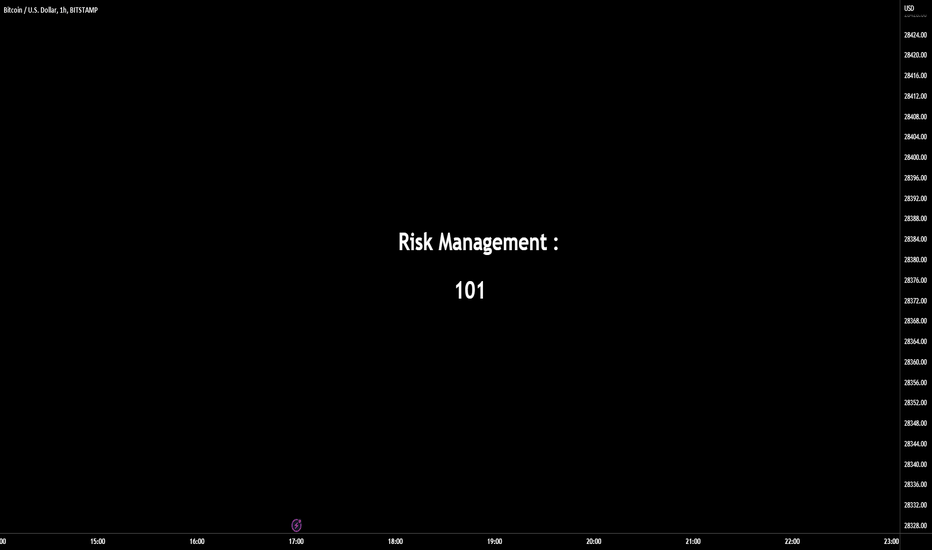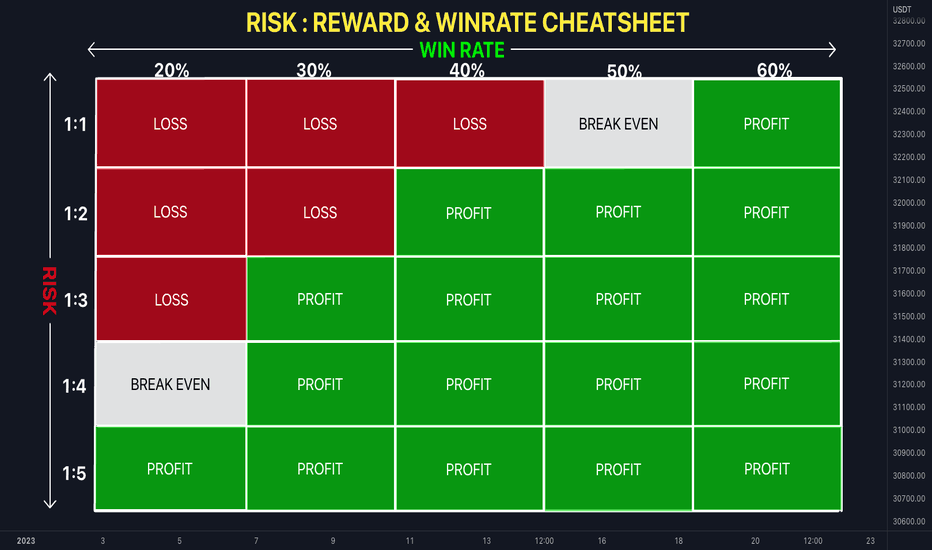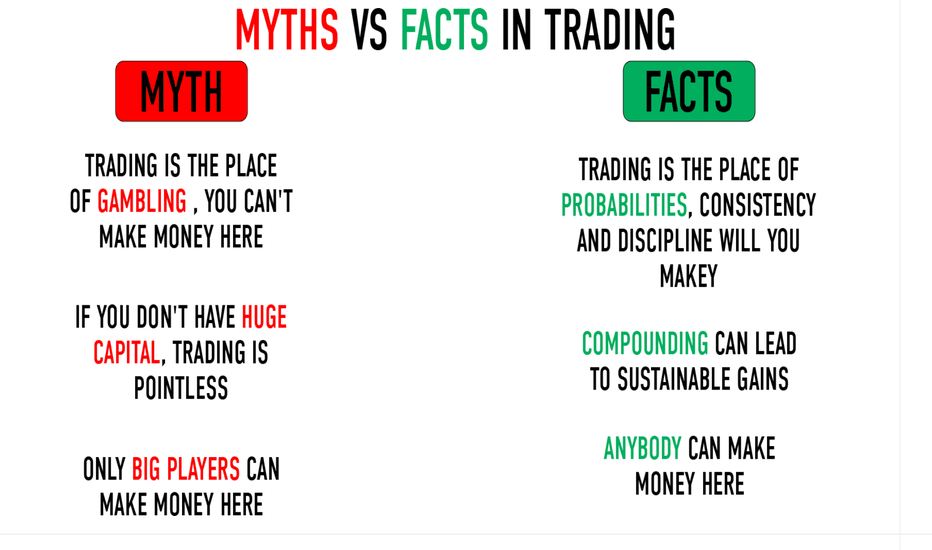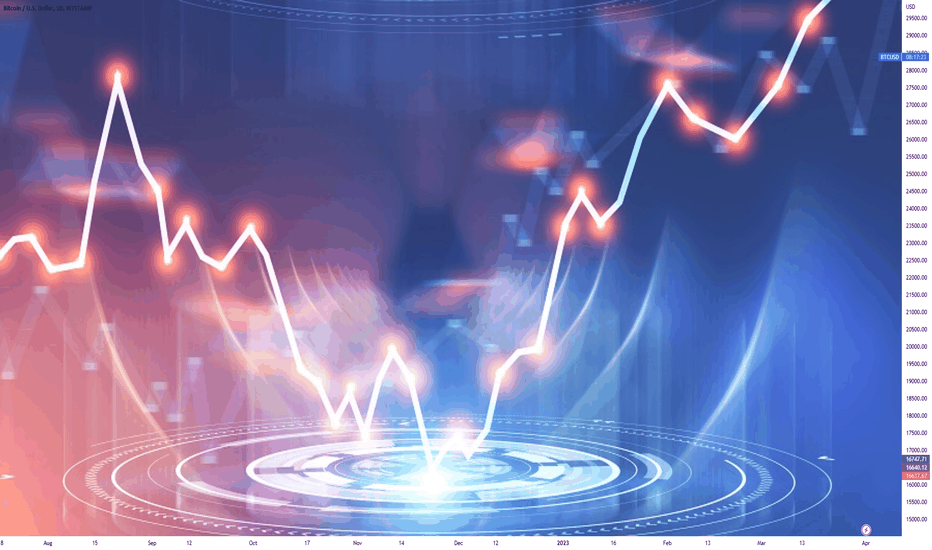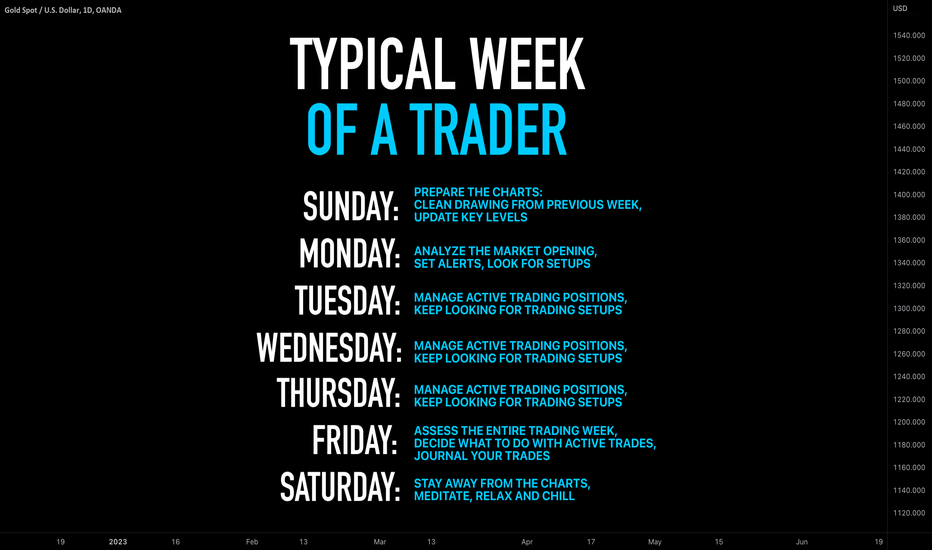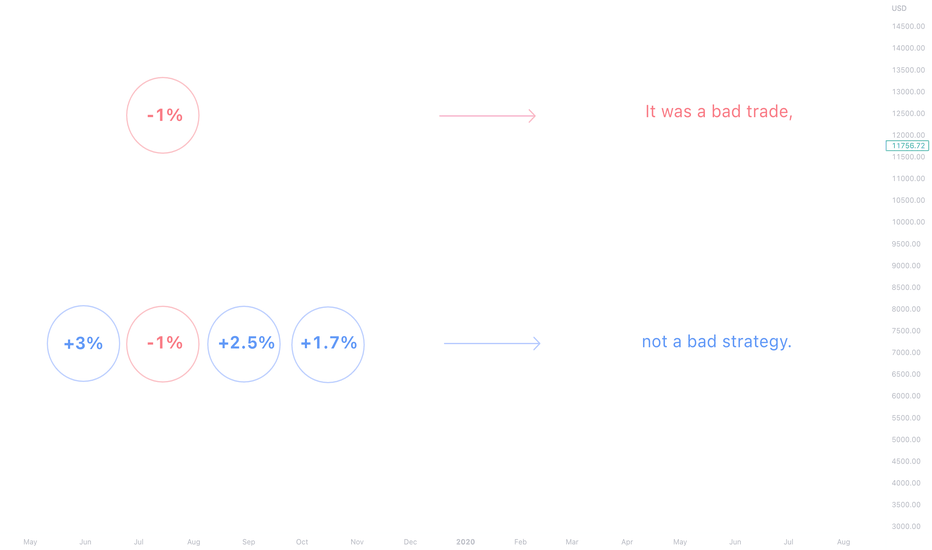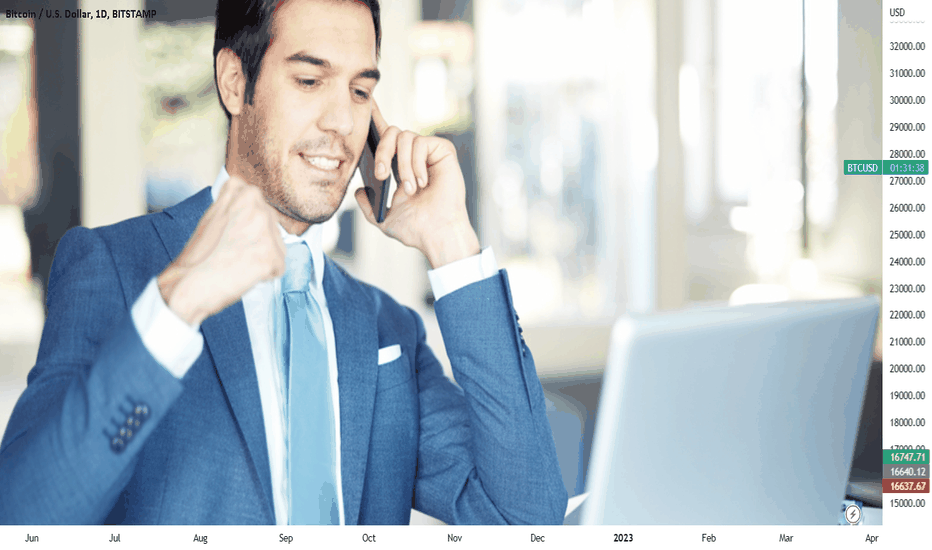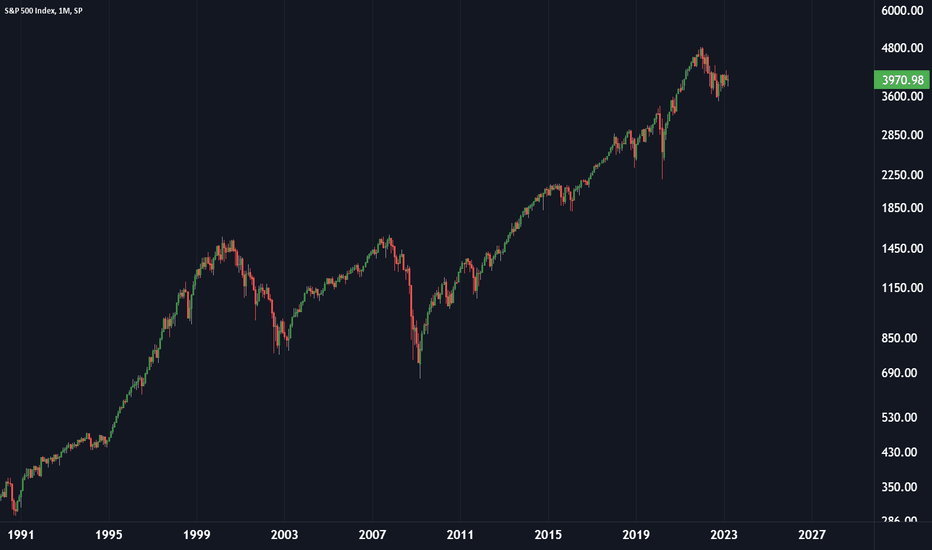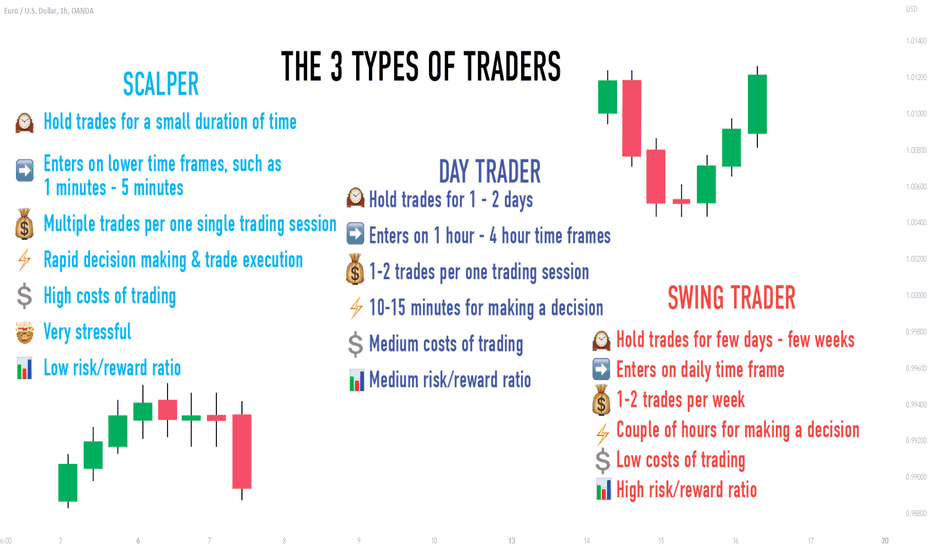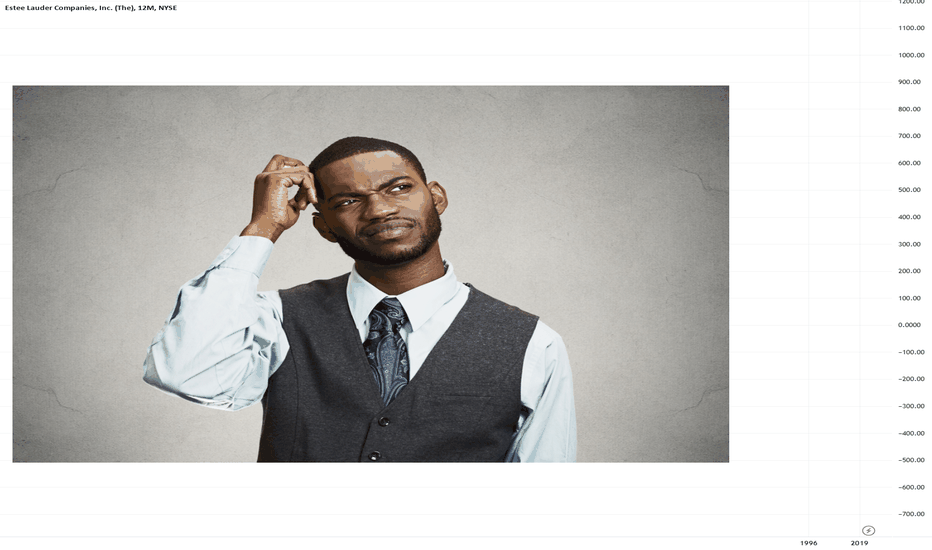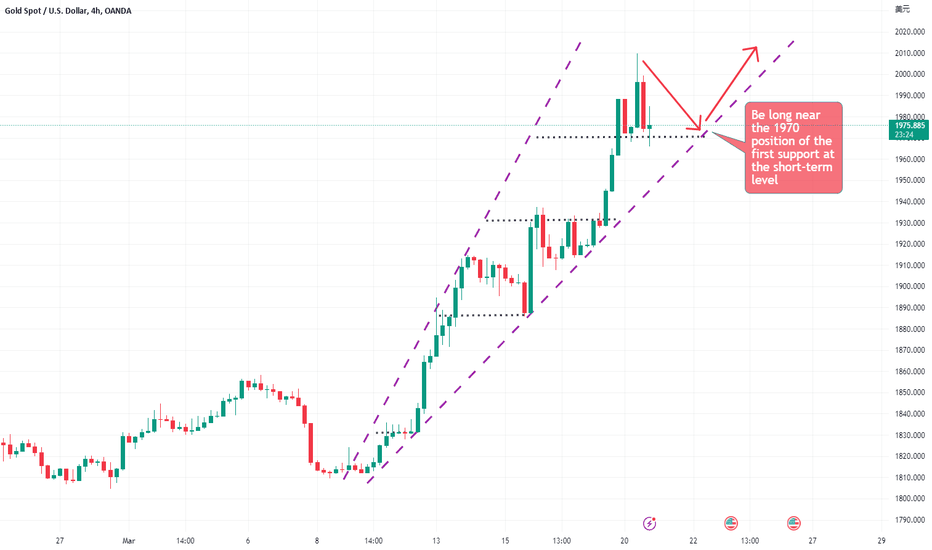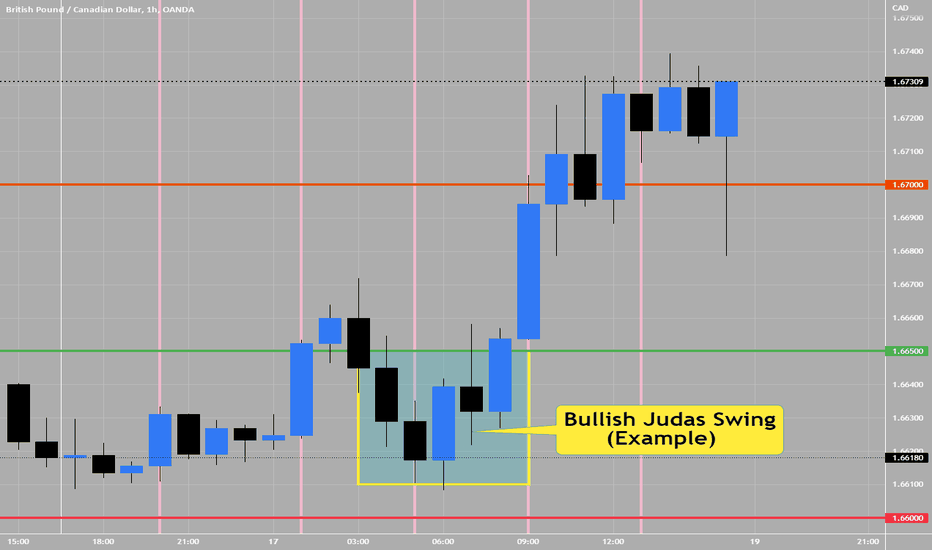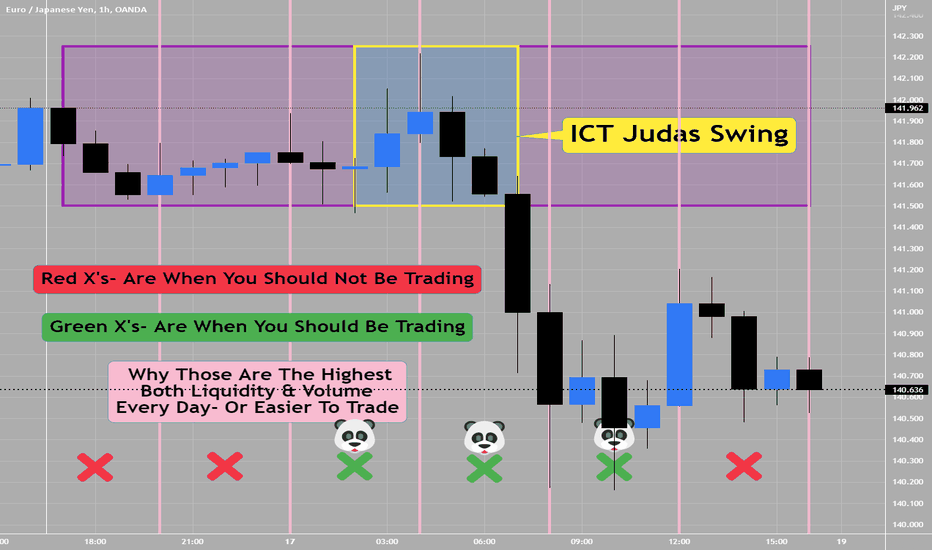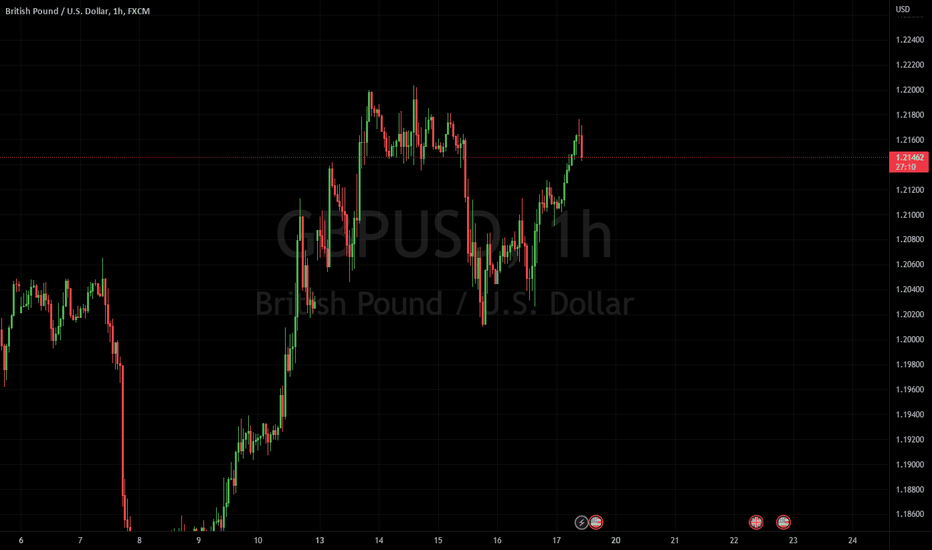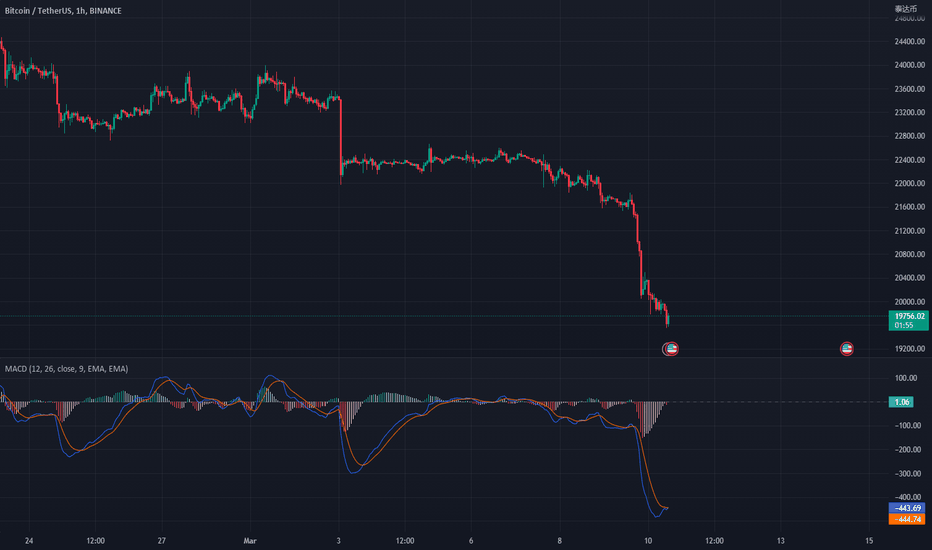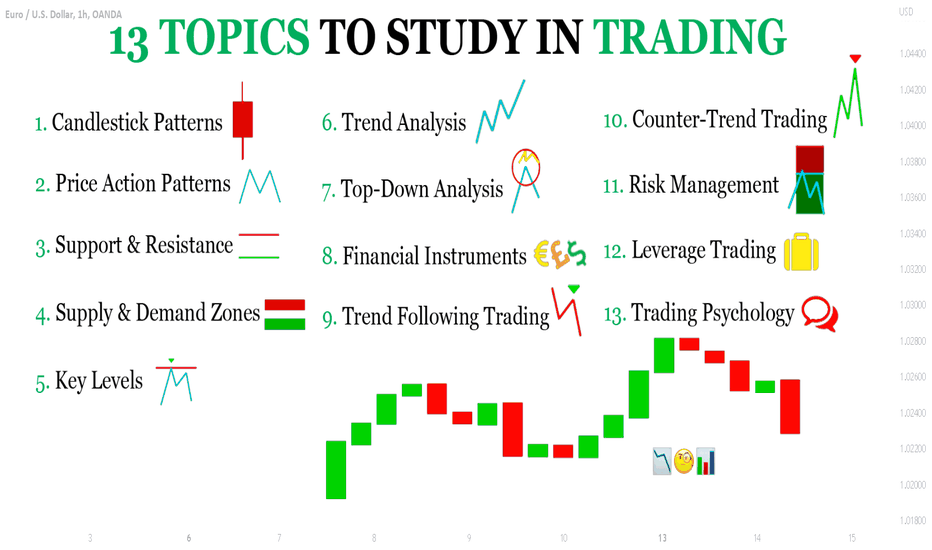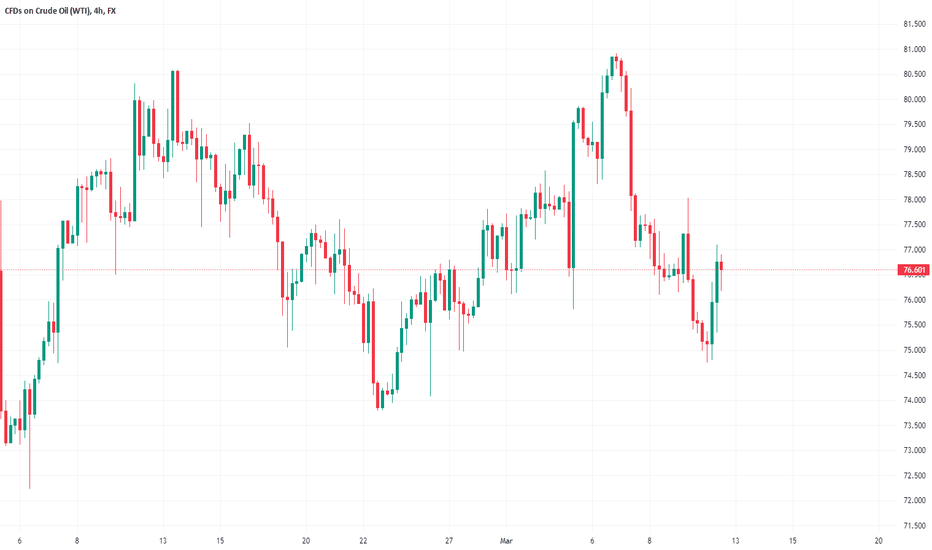Simple Math Defies Logic"The ones who make the most money lose the least when they are wrong"
Let's use a scalping trading style for example
Say you have a set risk reward ratio of
-10 pips for being wrong
+30 pips for being right
Start trading
Loss
Loss
Loss
Win
Loss
Loss
Loss
Loss
Loss
Win
Loss
Loss
Loss
Win
Win
Loss
Loss
Win
Loss
Loss
Wow, a lot of losses, but hold on.... You have the same amount of money you started with, minus maybe a small bit on commission.
How does that happen?
Let's put the running total (pips) next to each trade
Loss -10
Loss -20
Loss -30
Win 0
Loss -10
Loss -20
Loss -30
Loss -40
Loss -50
Win -20
Loss -30
Loss -40
Loss -50
Win -20
Win +10
Loss 0
Loss -10
Win +20
Loss +10
Loss 0
Final for the day = 0 ( -1.5 - 2.5 pips for commissions)
Accuracy rate: 30%
So in simple terms, by just using a simple risk management set up that allows you to win more than 1x the risk, you do not have to have a very high accuracy rate in order to make even a small profit.
It is very difficult to keep your mind in check about this simple math, because we look at each trade on it's own, instead of looking at a series of trades (for a day/week/month) to judge performance. Keeping the overall picture in mind, and just making sure you do not allow more risk on a position than you planned, and most cases you will begin to see an improvement on trading.
By not using stops, losses can quickly mount up, because losing streaks happen. Stick to the plan, and let your mind just sit in the corner mad about the stop rules (Ignore the feeling, like a 2 year old that didn't get ice cream, or because they weren't right, & just remember the math).
*If you move your stop, one of two things apply:
You are either finding more support for the idea, just a bad entry. Move the stop to what you would risk as an additional position had you taken the trade from the spot you decide to move the stop from, and count it as two trades.
If you had a small stop, but not the maximum risk you allow on the idea, then move it no further than you planned to risk as a maximum for a single trade.
Moving a stop because you have a reason is OK, just COUNT IT, and MAKE SURE you have a REASON to do so.
DO NOT just move it because you don't want to lose, or you will take out your own account very quickly.
Risk Management
⚠️ Risk:Reward & Win-Rate CheatsheetThe reward to risk ratio (RRR, or reward risk ratio) is maybe the most important metric in trading and a trader who understands the RRR can improve his chances of becoming profitable. Basically, the reward risk ratio measures the distance from your entry to your stop loss and your take profit order and then compares the two distances. Traders who understand this connection can quickly see that you neither need an extremely high winrate nor a large reward:risk ratio to make money as a trader. As long as your reward:risk ratio and your historical winrate match, your trading will provide a positive expectancy.
🔷 Calculating the RRR
Let’s say the distance between your entry and stop loss is 50 points and the distance between the entry and your take profit is 100 points .
Then the reward risk ratio is 2:1 because 100/50 = 2.
Reward Risk Ratio Formula
RRR = (Take Profit – Entry ) / (Entry – Stop loss)
🔷 Minimum Winrate
When you know the reward:risk ratio for your trade, you can easily calculate the minimum required winrate (see formula below).
Why is this important? Because if you take trades that have a small RRR you will lose money over the long term, even if you think you find good trades.
Minimum Winrate Formula
Minimum Winrate = 1 / (1 + Reward:Risk)
👤 @AlgoBuddy
📅 Daily Ideas about market update, psychology & indicators
❤️ If you appreciate our work, please like, comment and follow ❤️
😎MYTHS ABOUT TRADING BUSTED😎
⚛️The world of trading is full of myths and misconceptions. We often hear stories of overnight successes and devastating losses. It can be difficult to separate truth from fiction when it comes to trading. In this article, we will debunk some of the most common trading myths and provide the facts to help you make better investment decisions.
❌Myth: Trading is Gambling
✅Fact: Trading involves analyzing market trends, researching companies and industries, and making informed decisions based on data. Successful traders do not simply rely on luck; they systematically evaluate risk and reward before making trades.
❌Myth: You Need to be a Financial Expert to Trade
✅Fact: While a basic understanding of the market is important, you do not need a degree in finance to be a successful trader. There are numerous resources available to help beginners learn the basics of trading, including online courses, tutorials, and mentorship programs.
❌Myth: Day Trading is the Best Way to Make Money Quickly
✅Fact: Day trading involves buying and selling assets within a single trading day in order to profit on short-term price movements. While it can be lucrative, it is also risky and requires significant time and effort. Many successful traders prefer to take a long-term approach, focusing on investments that will appreciate over time.
❌Myth: You Need a Lot of Money to Start Trading
✅Fact: While having a larger investment portfolio can certainly provide more opportunities for profit, you do not need a huge amount of money to start trading. Many online brokers offer low minimum account balances, making it easier for beginners to start investing.
❌Myth: Trading is Only for the Wealthy
✅Fact: Trading is accessible to anyone with an internet connection and a willingness to learn. While high net worth individuals may have more resources to invest, anyone can start trading with a little bit of research and a willingness to take calculated risks.
❌Myth: Technical Analysis is the Only Way to Predict Market Trends
✅Fact: Technical analysis involves analyzing charts and data to predict future market trends. While it can be a valuable tool, it is not the only way to make informed trading decisions. Fundamental analysis, which involves evaluating a company's financial health and growth potential, is equally important.
❌Myth: Trading is a Solo Endeavor
✅Fact: Trading can be a solitary activity, but it is important to take advantage of opportunities to learn from and collaborate with other traders. Online forums like Tradingview, mentorship programs, and networking events can all provide valuable insights and support.
✳️In conclusion, there are many myths surrounding trading that can prevent individuals from taking advantage of its potential benefits. By separating fact from fiction, traders can make informed decisions and increase their chances of success. Whether you are a seasoned investor or a beginner, knowledge and education are essential to achieving your financial goals.
Thanks for reading bro, you are the best☺️
Like, comment and subscribe to boost your trading!
Dear followers, let me know, what topic interests you for new educational posts?
Risk Management Strategies Every Trader Should KnowIntroduction
Trading can be a profitable venture, but it also comes with its fair share of risks. In order to succeed as a trader, it is important to have a solid risk management plan in place. In this article, we will discuss key risk management strategies that every trader should know. These include determining your risk tolerance, using stop loss orders, implementing position sizing, diversifying your portfolio, and monitoring and adjusting your strategy.
Determine Your Risk Tolerance
The first step in developing a risk management plan is to assess your own risk tolerance. This is the level of risk that you are willing and able to take on for a given trade. There are several factors that can influence your risk tolerance, including your financial situation, experience level, and personal preferences.
To determine your risk tolerance, consider the amount of money that you are willing to risk per trade, as well as the maximum percentage of your portfolio that you are comfortable losing. It is important to be honest with yourself when assessing your risk tolerance, as taking on too much risk can lead to significant losses.
Use Stop Loss Orders
Stop loss orders are an essential tool for managing risk in trading. A stop loss order is an instruction to sell a security when it reaches a certain price, in order to limit losses. By setting a stop loss order, traders can limit their potential losses and protect their capital.
It is important to set stop loss orders at a level that reflects your risk tolerance and the volatility of the market. Traders should also be aware of the potential for slippage, which is when the execution price of a stop loss order is different from the desired price due to market volatility or other factors.
Implement Position Sizing
Position sizing is another important risk management strategy that traders can use to manage their exposure to risk. Position sizing refers to the amount of money that a trader invests in each trade, and is typically expressed as a percentage of the trader's overall portfolio.
Traders can use different approaches to position sizing, including fixed dollar amount, fixed percentage, or volatility-based position sizing. Each approach has its own advantages and disadvantages, and traders should choose the approach that best suits their risk tolerance and trading strategy.
Diversify Your Portfolio
Diversification is a key risk management strategy that involves spreading your investments across different assets or markets. By diversifying your portfolio, you can reduce your exposure to any single asset or market, and mitigate the potential for significant losses.
There are many different ways to diversify your portfolio, including investing in different types of assets (such as stocks, bonds, and commodities), or investing in different geographic regions or sectors. It is important to carefully consider the potential risks and benefits of each diversification strategy, and to choose a strategy that aligns with your risk tolerance and investment goals.
Monitor and Adjust Your Strategy
Finally, it is important to monitor and adjust your risk management strategy on an ongoing basis. This involves regularly reviewing your trading performance, identifying areas of weakness or risk, and making changes to your strategy as needed.
Traders should be aware of the potential for changes in market conditions or other factors that could impact their risk management strategy, and should be prepared to make adjustments as needed. This may involve increasing or decreasing position sizes, adjusting stop loss levels, or re-evaluating diversification strategies.
Conclusion
In summary, risk management is a crucial aspect of successful trading, and there are several key strategies that traders can use to manage their exposure to risk. These include determining your risk tolerance, using stop loss orders, implementing position sizing, diversifying your portfolio, and monitoring and adjusting your strategy. By taking a proactive approach to risk management, traders can minimize losses and maximize their potential for success.
THE TYPICAL WEEK OF A TRADER 🗓
In this educational article, I will teach you how to properly plan your trading week.
Sunday.
While the markets are closed, it is the best moment to prepare the charts for next week.
First of all, charts should be cleaned after the previous trading week: multiple setups and patterns become invalid or simply lose their significance and their stay on the charts will only distract.
Secondly, key levels: support and resistance, supply and demand zones and trend lines should be updated. Similarly to patterns, some key levels become invalid after a previous week, for that reason, structures should be reviewed.
Monday.
Analyze the market opening, go through your watch list and check the reaction of the markets.
Flag / mark the trading instruments that you should pay a close attention to. Set alerts and look for trading setups.
Tuesday. Wednesday. Thursday.
If you opened a trading position, keep managing that.
Pay attention to your active trades, go through your watch list and monitor new trading setups.
Friday.
Assess the entire trading week. Check the end result, journal your winning and losing trades. Work on mistakes.
Decide whether to keep holding the active position over the weekend or look for a way to exit the market before it closes.
Saturday.
Stay away from the charts. Meditate, relax and chill while the markets are closed.
Trading for more than 9-years, I found that such a plan is the optimal for successful full-time / part-time trading. Try to follow this schedule and let me know if it is convenient for you
❤️Please, support my work with like, thank you!❤️
Trading is a game of numbers and probabilitiesFirst of all, let us clarify, that what we mean by a "bad trade" is simply a transaction that was unsuccessful . There are no "good" or "bad" trades as the whole system of trading is random and unpredictable. In other words, if we knew how to differentiate between bad and good trades, then technically, we would always choose to enter good trades, right? Or should we wait for our trades to close before we label them "good" or "bad"?
Anyways, moving to the main part, we would like you all (especially beginners) to embed the following in their minds forever: trading is a game of numbers and probabilities.
No, you will not have a 100% win rate.
No, you won't be making 200 pips per day.
Yes, you will have losses.
Yes, things are gonna get emotional.
The above-stated may seem bizarre to newbies. "Like, what do you mean I cannot make 200 pips per day? This Free Forex Signals group on Telegram shares 50 signals per day and promises me a 100% return per month and you are telling me I cannot make 200 pips a day? Hahaha, do not make me laugh".
Been there, listened to that.
At the beginning of our trading careers, we are greedy, emotional, and extremely optimistic about our skills and abilities. We get angry, question ourselves, change our strategy every second day and so forth. All that up until we get more mature and wise in the markets. With time, we gain experience and double up on our skills; and that is exactly when we become acknowledging the market for what it actually is and understand how it functions.
Experienced traders think, move, and act in probabilities. They predetermine their risk, calculate all possible outcomes, execute at ease knowing that they are following their strategy. To put it into simple English, they do not get mad over one loss, because they know that their backtested and fully planned strategy is there to lead them towards long-term profitability and consistency.
Multiple Time Frames Can Multiply Returns
In order to consistently make money in the markets, traders need to learn how to identify an underlying trend and trade around it accordingly.
Multiple time frame analysis follows a top-down approach when trading and allows traders to gauge the longer-term trend while spotting ideal entries on a smaller time frame chart. After deciding on the appropriate time frames to analyze, traders can then conduct technical analysis using multiple time frames to confirm or reject their trading bias.
Multiple time frame analysis, or multi-time frame analysis, is the process of viewing the same currency pair under different time frames. Usually the larger time frame is used to establish a longer-term trend, while a shorter time frame is used to spot ideal entries into the market.
HOW TO IDENTIFY THE BEST FOREX TIME FRAME?
Many traders, new and experienced, want to know how to identify the best time frame to trade forex. In general, traders should select a time frame in accordance with:
the amount of time available to trade per day
the most commonly used time frame utilized to identify trade set ups.
For example, day traders typically have the whole day to monitor charts and therefore, can trade with really small time frames. These range anywhere from a one-minute, to the 15-minute, to the one-hour time frame. Day traders that identify their trade set ups on the one-hour time frame can then zoom into the 15-minute time frame to spot ideal market entries.
Multiple time frame analysis usually produces high win rate, guaranteeing very limited risk.
Dear followers, let me know, what topic interests you for new educational posts?
Top10 Mistakes to avoid as a New TraderIntroduction
When starting out as a trader or investor, it is important to be aware of the mistakes that can be made. Mistakes are common, and even experienced traders and investors make them from time to time. However, new traders and investors are particularly vulnerable to making mistakes, which can lead to significant losses. In this article, we will discuss the top 10 mistakes to avoid as a new trader or investor, and provide tips on how to avoid them.
Mistake 1: Lack of education
One of the biggest mistakes that new traders and investors make is not educating themselves about the markets they are investing in. It is important to have a basic understanding of the financial markets, including the stock market, foreign exchange market, and commodity markets.
Before making any trades or investments, new traders and investors should spend time learning about the different financial instruments, such as stocks, bonds, and options. They should also understand the basic concepts of fundamental and technical analysis, which can help them identify profitable trades.
There are many educational resources available to new traders and investors, including books, online courses, and seminars. Some of the most popular books on investing include "The Intelligent Investor" by Benjamin Graham, "The Little Book of Common Sense Investing" by John Bogle, and "A Random Walk Down Wall Street" by Burton Malkiel.
Mistake 2: Failure to set goals
Many new traders miss out on setting goals. Having clear and realistic goals is important in trading or investing because it helps traders and investors stay focused and motivated.
Some common goals for new traders and investors include building wealth, generating passive income, and achieving financial independence. Goals should be specific, measurable, achievable, relevant, and time-bound (SMART). For example, a SMART goal for a new investor could be to earn a 10% return on their investment within the next 12 months.
Mistake 3: Emotion-based decision making
Emotions can be a trader's worst enemy. Fear, greed, and hope can all cloud judgement and lead to poor decision-making. New traders and investors are particularly vulnerable to emotional biases, such as the tendency to hold on to losing trades for too long or to sell winning trades too quickly.
To avoid emotional biases, new traders and investors should develop a trading plan and stick to it. They should also set stop-loss orders, which are orders to automatically sell a security when it reaches a certain price, to limit their losses.
Mistake 4: Not having a plan
New traders and investors often make the mistake of trading without a plan. A trading plan is a written set of rules that outlines a trader's entry and exit criteria, risk management strategy, and other important factors.
A trading plan should include the trader's goals, risk tolerance, and trading strategy. It should also outline the types of securities the trader will invest in and the timeframe for holding those securities. A trading plan is important because it helps traders avoid impulsive decisions and stick to a consistent strategy.
Mistake 5: Lack of diversification
Another common mistake that new traders and investors make is failing to diversify their portfolio. Diversification involves spreading your investments across different asset classes and industries, which can help to mitigate risk and protect your portfolio against losses.
For example, if you invest all of your money in a single stock or industry, you run the risk of losing everything if that stock or industry experiences a significant downturn. However, by diversifying your portfolio, you can help to reduce your exposure to any one particular investment and increase your chances of long-term success.
There are many ways to diversify your portfolio, such as investing in a mix of stocks, bonds, and mutual funds, or investing in companies across different industries and sectors.
Mistake 6: Chasing trends
Chasing trends is a pitfall that many undisciplined traders make and this also happens to professionals. This can be dangerous and lead to significant losses. Chasing trends involves investing in a stock or asset solely because it has recently experienced a significant increase in price, without considering the underlying fundamentals of the investment.
While it may be tempting to jump on board with a hot trend, it's important to remember that these trends are often short-lived and can quickly reverse direction. As a result, investing in a trend without doing your due diligence can result in significant losses.
Instead of chasing trends, focus on identifying investments with strong fundamentals, such as a history of consistent earnings growth or a solid balance sheet. By investing in quality companies with a proven track record, you can increase your chances of long-term success.
Mistake 7: Overtrading
New traders and investors tend to 'overtrade'. Overtrading involves making too many trades or investments, often based on emotional impulses or a desire to make a quick profit.
While it may be tempting to try to make as many trades as possible, overtrading can be harmful to your portfolio. Each trade comes with associated fees and commissions, which can add up quickly and eat into your profits. Additionally, making too many trades can increase your exposure to risk and volatility, which can lead to significant losses.
Instead of overtrading, focus on making well-informed, strategic trades based on your plan and goals. By being patient and selective with your trades, you can increase your chances of long-term success.
Mistake 8: Ignoring risk management
One of the most common mistakes new traders and investors make is ignoring risk management. Risk management is the process of identifying, analyzing, and controlling potential risks associated with an investment or trade. This includes setting stop-loss orders, diversifying your portfolio, and understanding the potential risks associated with each investment.
Many new traders and investors focus on potential profits and forget to consider the risks involved. This can lead to significant losses and can quickly wipe out an entire investment account.
There are several ways to manage risk, including setting stop-loss orders, diversifying your portfolio, and conducting thorough research on each investment opportunity. Stop-loss orders are an effective tool to limit potential losses on any given trade. Diversification is also an effective way to manage risk by spreading your investments across different asset classes, such as stocks, bonds, and commodities.
By ignoring risk management, new traders and investors increase the likelihood of experiencing significant losses. It is important to be proactive in managing risk and to always be mindful of the potential downside of any investment.
Mistake 9: Focusing too much on short-term gains
New traders and investors are focusing too much on short-term gains. While it is natural to want to see immediate returns on your investments, it is important to keep a long-term perspective in mind. Focusing too much on short-term gains can lead to impulsive decision-making and can cause investors to overlook the potential long-term value of an investment.
Short-term gains are often associated with higher risk, and it is important to remember that high risk can lead to high losses. By focusing solely on short-term gains, new traders and investors may overlook quality investments that have the potential for long-term growth and stability.
It is important to balance short-term gains with a long-term perspective. This means taking the time to research potential investments, identifying investments that align with your overall investment goals, and being patient with the investment process.
Mistake 10: Lack of patience
Finally, one of the biggest mistakes new traders and investors make is a lack of patience. Patience is critical in trading and investing, as it takes time to see returns on your investments. It is important to remember that investing is a marathon, not a sprint.
Many new traders and investors are eager to see quick returns on their investments, and they often become impatient when they don't see immediate results. This can lead to impulsive decision-making and can cause investors to sell their investments prematurely, often at a loss.
It is important to remember that successful investing takes time and patience. By taking the time to research potential investments, setting realistic expectations, and being patient with the investment process, new traders and investors can avoid making hasty decisions that can lead to significant losses.
Conclusion
In summary, trading and investing can be a rewarding and lucrative endeavor, but it is important to avoid common mistakes that can lead to significant losses. By educating yourself, setting goals, managing your emotions, having a plan, diversifying your portfolio, avoiding trend chasing, avoiding overtrading, managing risk, focusing on the long-term, and being patient, you can increase your chances of success as a new trader or investor.
Remember, the key to success is to approach trading and investing with a long-term perspective and to be mindful of the potential risks and rewards associated with each investment opportunity. By avoiding these common mistakes and staying disciplined in your approach, you can achieve your financial goals and enjoy a successful trading and investing career.
2 Free Online Games that Have Helped Me Become a Better Investor2 Free Online Games that Have Helped Me Become a Better Investor.
So Im in the middle of reading the " A Man of for All Markets" by Edward O. Thorp, and its fascinating. Hes a mathematician who proved there was a potential edge in blackjack (21) based on the cards that were left in the deck. He also went on to be investing fund manager who focused on covered calls and warrants and had a consistent track record for 20-25% annual returns. But his logic covered in his book focused on not only the odds of winning but the sizing of bets in both playing games and investing.
Risk management and bet sizing is not spoken about enough in life I believe. In the age of YOLO and wall street bets, clearly its not celebrated enough. A YOLO bet is a massive bet because 'you only live once'. how silly mathematically and how foolish from a consistency basis. Been there done that.
Bet sizing is key for survival. If you cant endure and survive long enough to be massively right, then your out of the game.
In the video I share 2 games that I think are awesome for practicing these concepts. I really I had learned to play and practice these concepts in games like this in college or high school. Its a math simulation. the Coin flip game is fantastic for learning how to manage risk and bet sizing. The Cashflow game by rich dad poor dad is awesome for taking investment habits and cash managements and applying them into a mini lifecycle that rhymes with real life.
If youre new to investing, or just sharpening your skills, I definitely recommend both games.
Have a great day, Cheers!
RISKOMETER Based on Your Trading Style ⚠️
Hey traders,
In this educational post, we will discuss the relation of risk to your trading style.
1️⃣ High Frequency Trading (HFT)
It is a complex algorithmic approach that is used to operate on second(s) time frames.
Such a style is considered to be the riskiest one.
With a very high frequency of order execution and sophisticated strategies, it requires a very high level of experience and proper software and hardware for successful operations.
2️⃣ Scalping
It is a manual trading style with operations on minutes time frames.
With the average holding period ranging from minutes to hours, scalping requires a high degree of attention and constant charts monitoring.
Being one of the most profitable trading styles for retail traders, scalping involves an extremely high risk and mental load.
3️⃣ Day trading
The form of speculation in which the traders attempt to make profits within a single trading day.
Occasionally, however, day traders may hold their positions overnight.
Day trading is considered to be slower than scalping, with the trade execution on hourly time frames.
Slower pace drastically reduces risks also limiting the potential gains.
4️⃣ Swing trading
It is a style of trading that is aimed to make profits on swing moves, with an average holding period ranging from days to weeks.
4H time frame is the lowest time frame where swing traders usually operate, and a daily time frame is usually the highest one.
The operations on higher time frame dramatically reduces the noise and degree of manipulations, making that style of trading relatively safe.
5️⃣Investing (Position Trading)
Trading / investing style aiming to make long-term profits.
The average holding time of a position trader may expand to years.
In comparison to other trading styles, investing generally produces the smallest gain. That is, however, compensated by extremely low risks.
Correct understanding of relations between trading styles and potential risks is crucially important for a selection of an appropriate style for you.
Shorter is the holding period and operational time frames, higher is the risk, but higher are the potential gains.
You should pick the style that fits your risk-tolerance and expectation.
❤️Please, support my work with like, thank you!❤️
Scalper, Day Trader & Swing Trader | Choose Your Path
There are thousands of different ways to trade the market.
During the last 100 years, various trading strategies and techniques were invented.
One of the ways to categorize them is to split them by types of traders.
Such a category type will lean on 2 main elements:
trading frequency and time frame selection.
1️⃣ - Scalper
I guess 99% of newbie traders start from scalping.
Trying to catch quick market moves and become rich quick,
newbies are practicing different scalping strategies.
What is funny about scalping is the fact that such a trading style is considered to be the easiest by the majority while remaining one of the hardest in the view of pros.
The main obstacle with scalping is a constant focus and rapid decision-making.
Scalpers usually open dozens of trading positions during the trading session, most of the time being in front of the screen constantly.
Paying huge commissions to the broker and dealing with complete chaos on lower time frames, the majority simply can't survive the pressure and drop, leaving the pie to true gurus.
2️⃣ - Day Trader
Day trading or intraday trading is the most appealing to me.
Staying relatively active, the market gives some time for the trader for reflection & thinking.
Opening and managing on average 1-2 trades per trading session, the intraday trader is granted a certain degree of freedom.
However, with declining volatility , quite ofter intraday traders get a relatively low risk/reward ratio for their trades,
3️⃣ - Swing Trader
Swing trading is the best choice for traders having a full-time job.
Primarily being focused on daily/weekly time frames, swing trading is not demanding for a daily routine and aims at catching mid-term/long-term market moves.
With an average holding period being around 2 weeks and opening 1-2 trading positions per week, swing trading is considered to be the least emotional and involves low risk.
The main problem with swing trading is patience.
Correctly identifying the market trend and opening a trading position,
the majority tends to close their positions preliminary not being patient enough to let the price reach their target.
Which trading type do you prefer?
Let me know, traders, what do you want to learn in the next educational post?
Should I stay or should I go?Three factors for good trade management
Knowing when to make your move is key to being a successful and profitable trader. Here are three things you need to handle to keep on track:
1. Know the probability of the trade
Make sure you know whether your trade is low or high probability and whether it’s against the trend or with it. If a trader goes long in a short market it’s a low-probability trade so more than likely it is going to end up in a losing trade.
If you have a high-probability trade that failed, the market likely wants to change direction. If you have a high-probability trade that you don’t make a lot of points on, it means the market is slowing down or reversing.
Sometimes low-probability trades also bring in points. Lower probability trades are against the prevailing trend, so taking a trade to the opposite side becomes preferable and may end up being a high-probability trade. That is because the trends start to change from the lower time frames to the higher timeframes. But you have to keep an eye on the higher ones especially as it might be a retracement on a higher-level timeframe (typically a 5 or 15 minute timeframe).
2. Know your rules for risk
Be very clear how much money you want to allocate to a trade. Is your rule that you only ever risk half a percent per position or a maximum of 6% of your portfolio on any one trade? Having this clear boundary means that if you lose a few percent it doesn’t make a material difference to your account, your mindset and your wellbeing.
Remember that your risk management will improve over time. Never get put off by the occasional trade that goes against you. If it doesn’t work out, look at your trading plan and see where there is something that could be changed.
3. Practice your strategy and approach
Believe in your system and stick to it and your trading plan strictly, even if it looks like the market is going against you. Of course not all trades will be successful - with any business you have profits and losses. As long as the profits are more than the losses it’s ok.
It’s about practice too, which includes practicing the skill of not doing anything for a few hours until you see a setup that meets your criteria. You never want to be making involuntary or emotional moves.
The fastest area of wealth accumulation in the world-the forexAn investment field where one opportunity is enough to change one's destiny!
A market that works miracles every day!
Entering the new century, foreign exchange, an investment tool with infinite charm, is attracting the attention of more and more people. This market full of opportunities and challenges is changing our destiny all the time, so much so that it is loved by more and more people.
Advantages of the foreign exchange market:
1.Low threshold for investment amount;
2.The investment period can be long or short, buy and sell as you go, and the liquidity is extremely high.
3.The highest return on investment, you can get more than several times the amount of investment funds.
4.The transaction procedures are quick and easy. You only need to enter the transaction procedures, which can be completed in a very short time.
5.Trading flexibility is high, and there are many profit opportunities in the dual-track of buying long and selling short.
6.The impact environment is relatively fair, the information channels are smooth, and it will not be operated by large companies. The principles of fairness, impartiality, and openness are guaranteed. There are many factors that affect it, and the relationship between supply and demand has a great impact.
7.The degree of risk is relatively high, but foreign exchange trading operations are flexible, mobile, rapid, and risks can be controlled and prevented.
How to quickly accumulate wealth with small funds:
1. Survival first, development second.
2. Only do short-term intraday trading.
3. Operate no more than 5 times a day, and try not to place orders after the daily profit exceeds US 1,000.
4. Only 2-3 varieties are made every day.
In the trading process, at the same time, establish that opportunities are available every day, and you need to maintain the concept of waiting patiently for opportunities, and overcome the impatience of eager to win; at the same time, make rational use of stop losses, establish the concept of safety in the bag, and turn floating profits into real profits in a timely manner.After trading, find the time period when you make the most profit every day, try to give full play to your advantages in this time period, and summarize your experience every day to continuously improve your tactics.
Judas Swing (Bullish Example) Part 2The Judas swing term was named by ICT, he dubbed this swing concept and utilizes it upon the London Open. The idea is, the market maker will rally or sell price, normally just above or below the Asian session high or low (depending on institutional order flow bias) tricking buyers or sellers into the market to follow its direction. As the Judas swing high or low is formed, price is quickly reversed either taking out stops and or leaving traders out of the game.
The Judas swings happen on all time frames, but 1hr are the best for scalping or day trading- they happen a lot every week.
* Please check out your favorite forex pairs on 1 hour time frame- you will see that they four (4) hour candlestick set up happens at the same time over and over. Why not trade it? Just figure out the risk management around the ATR of pair you trade.
Noted on attached chart is:
Example of a bearish Judas Swing on Eur/Jpy 1 hour chart
and noted when you should not be trading RED x's and when you should be trading GREEN x's. Why? Because each day there are 12 hours of low liquidity and low volume and then there are 12 hours of high liquidity and high volume.
Make Forex trading as easy as you can- trade with big banks not against them and remember that both time and price are most important in Forex.
Good Luck,
Panda
Can you do a 50 pip box on this trade? 1:1 Risk Reward- is it worth it? It depends if you have a high win rate with 1:1 or you need trades to be higher.
What is an ICT Judas Swing?The Judas swing term was named by ICT, he dubbed this swing concept and utilizes it upon the London Open. The idea is, the market maker will rally or sell price, normally just above or below the Asian session high or low (depending on institutional order flow bias) tricking buyers or sellers into the market to follow its direction. As the Judas swing high or low is formed, price is quickly reversed either taking out stops and or leaving traders out of the game.
The Judas swings happen on all time frames, but 1hr are the best for scalping or day trading- they happen a lot every week.
* Please check out your favorite forex pairs on 1 hour time frame- you will see that they four (4) hour candlestick set up happens at the same time over and over. Why not trade it? Just figure out the risk management around the ATR of pair you trade.
Noted on attached chart is:
Example of a bearish Judas Swing on Eur/Jpy 1 hour chart
and noted when you should not be trading RED x's and when you should be trading GREEN x's. Why? Because each day there are 12 hours of low liquidity and low volume and then there are 12 hours of high liquidity and high volume.
Make Forex trading as easy as you can- trade with big banks not against them and remember that both time and price are most important in Forex.
Good Luck,
Panda
Learn What is Confirmation Bias | Trading Psychology 🧠
In this educational article, we will discuss one of the most common cognitive errors of newbie traders - a confirmation bias.
In order to better understand that term, I want to start with the example:
Let's say that after doing some research, you are highly convinced that Bitcoin is bullish and that it is a decent investment.
You decide to buy that from 50.000 level, expecting the exponential growth.
Instead of growing, however, the market starts falling rapidly.
Rather than closing your position in loss, you decide to do a new research and execute the analysis, you start looking for the proof of your pre-existing beliefs. You completely neglect the voices of Bitcoin sceptics and ignore bearish clues on the price chart.
You consider only the facts that support a bullish outlook, not letting you accept the other point of view.
You become a victim of a confirmation bias.
Unfortunately, such a psychological trap frequently prevents a closing of a trading position in time, leading to substantial losses.
Confirmation bias is a common psychological error that makes a subject overvalue the information that upholds his existing beliefs and undervalue the opposing one.
Here are the most common symptoms of that trap:
1️⃣One is neglecting the objective facts.
2️⃣One is interpreting information in a way to support the existing beliefs.
3️⃣One is considering only the facts that conform with his point of view.
4️⃣One is completely ignoring the information that challenges his beliefs.
The only way to beat a confirmation bias in trading, is to learn to analyze the market from sellers' and from buyers' perspective. Your task is to compare the view of the 2 sides, and pick the one that is stronger, holding in mind the fact that everything can change.
You should always remember of the changing nature of financial markets and be ready to always reassess your views.
❤️Please, support my work with like, thank you!❤️
How to succeed on the marketThere are so many opportunities in a single pair that one can maximise. The secret is to choose one or two pairs and maximize them. You are not going to miss out on anything. Many traders are psychologically affected by the following:
1. Fear of Missing Out (FOMO). Many think if I focus on only one pair I will miss out on the opportunities from other pairs. No, you won't because in one single pair if you are an intraday trader there are so many opportunities to capitalize on. FOMO cause traders to traders to jump into the markets too early and too late for the fear that they will miss out on an opportunity. There is no single opportunity in the market that will make you rich and opportunities are never going to end.
Before you started out in forex trading you had missed out on so many opportunities. Remember forex did not start when you started and will not end when you stop trading. Before you were born forex was already there which means opportunities were there. So missing one opportunity today should not make you lose your mind and be hard on yourself.
Think of opportunities like public buses. When you reach the bus station and find that the bus has left, do you start cursing yourself and being hard on yourself? The answer is no! You simply relax and wait for the next one. If the next one doesn't please you, you still wait for the next one. The same way you never feel bad when you miss one bus is the same way you should feel one you miss one trade. Don't feel bad. Know that another opportunity will come your way.
We have been raised with the faulty thinking that money doesn't grow on trees. That's a belief so deep that when we get into the market, we want to make all the money in one trade. Our faulty thinking whispers to us that there may never be another opportunity like this so we tend to become careless and leverage.
90% of trading is psychological and only 10% is technical. Once you understand that you are dealing with a market with abundant opportunities to make you rich you will trade stress-free. Even if you take a loss, you will not take it personally knowing that as long as am using good risk management, another opportunity will come my way and I will recover my loss.
Don't go into revenge trading because of one loss. Losses are part of the game. Learn to live with them and love them the same way you love take profit.
Here is the truth, Losses are under your control, and profits are not. If you take care of the losses the market will take care of the profits.
Causes of FOMO
1. Lack of a trading plan
2. Lack of trading discipline
3. Information overload
4. Social media influence
5. Having a scarcity mentality
The Role of ChatGPT in Algorithmic TradingThe Role of ChatGPT in Algorithmic Trading
1. Introduction
In recent years, algorithmic trading has become an increasingly important aspect of the financial markets. Algorithmic trading involves using computer programs to execute trades based on predetermined rules and algorithms, with the goal of maximizing returns and minimizing risk. The use of algorithms allows traders to make rapid, data-driven decisions and respond to market conditions faster than traditional human traders.
Natural language processing (NLP) is a field of computer science that focuses on the interactions between computers and human language. In the context of algorithmic trading, NLP techniques are used to analyze vast amounts of financial news, social media, and other sources of information to identify potential trading opportunities. By analyzing this data, traders can make informed decisions and gain a competitive edge in the market.
One of the key tools used in NLP for algorithmic trading is ChatGPT, a large language model trained by OpenAI. ChatGPT is a powerful tool that can analyze vast amounts of text data and generate human-like responses. Its capabilities include natural language understanding, machine translation, text summarization, and text completion.
With its ability to analyze and understand large amounts of text data, ChatGPT is an essential tool for traders looking to gain a competitive edge in the market. For example, ChatGPT can be used to analyze financial news articles and social media posts to identify companies that are likely to experience a significant change in their stock price. By analyzing the sentiment of these articles and posts, ChatGPT can determine whether there is a positive or negative outlook for a particular company, which can be used to inform trading decisions.
In addition to sentiment analysis, ChatGPT can also be used to generate summaries of news articles, which can save traders valuable time and allow them to quickly digest important information. ChatGPT can also be used to generate text responses to customer inquiries, freeing up traders to focus on more important tasks.
Overall, the use of NLP and ChatGPT in algorithmic trading is becoming increasingly important. As the amount of data available to traders continues to grow, the ability to quickly and accurately analyze that data will become essential for achieving success in the market. With its powerful NLP capabilities, ChatGPT is poised to play a significant role in the future of algorithmic trading.
2. NLP Techniques for Algorithmic Trading
Natural language processing (NLP) is an essential tool for algorithmic trading, enabling traders to quickly and accurately analyze large volumes of text data. In this section, we'll explore some of the key NLP techniques used in algorithmic trading, including analysis of financial news and social media, sentiment analysis, and identification of potential trading opportunities.
One of the most powerful applications of NLP in algorithmic trading is the analysis of financial news and social media. By analyzing news articles and social media posts, traders can gain insight into the market sentiment and identify emerging trends or potential trading opportunities. For example, if a large number of news articles and social media posts are discussing a particular company, it may be an indication that the company is about to experience a significant change in its stock price.
Sentiment analysis is another important NLP technique in algorithmic trading. Sentiment analysis involves using NLP algorithms to determine the emotional tone of a particular piece of text. By analyzing the sentiment of news articles, social media posts, and other sources of information, traders can gain insight into the market sentiment towards a particular company or industry. This information can then be used to inform trading decisions.
Identification of potential trading opportunities using NLP is another key application of this technology. By analyzing large volumes of data, including news articles, social media posts, and other sources of information, traders can identify emerging trends or potential trading opportunities. For example, by analyzing news articles and social media posts, traders may identify a new technology that is rapidly gaining popularity, indicating a potential investment opportunity.
Overall, the use of NLP techniques in algorithmic trading is becoming increasingly important. With the amount of data available to traders continuing to grow, the ability to quickly and accurately analyze that data will be essential for achieving success in the market. NLP techniques, including the analysis of financial news and social media, sentiment analysis, and identification of potential trading opportunities, are powerful tools that can help traders gain a competitive edge and achieve success in the market.
3. Predictive Models with ChatGPT
Predictive models are an essential tool for algorithmic trading, enabling traders to identify patterns and predict future market trends. In this section, we'll explore how ChatGPT can be used to develop predictive models and the advantages of using this technology.
At its core, predictive modeling involves using historical data to identify patterns and predict future trends. This process involves analyzing large volumes of data to identify patterns and trends that can be used to inform trading decisions. With the increasing amount of data available to traders, the ability to quickly and accurately analyze that data is becoming essential for achieving success in the market.
ChatGPT is a powerful tool that can be used to analyze large datasets and identify patterns that may be missed by other analytical tools. With its ability to understand natural language, ChatGPT can analyze vast amounts of financial news, social media, and other sources of information to identify patterns and trends. This information can then be used to develop predictive models that can be used to inform trading decisions.
One of the key advantages of using ChatGPT in developing predictive models is its ability to understand the context of the data it is analyzing. Unlike other analytical tools, which may only be able to identify patterns based on simple statistical analysis, ChatGPT can analyze text data to understand the context and nuances of the information being analyzed. This allows traders to identify patterns and trends that may not be immediately apparent using other analytical tools.
Another advantage of using ChatGPT in developing predictive models is its ability to learn from new data. As more data becomes available, ChatGPT can be trained to recognize new patterns and trends, improving the accuracy of its predictions over time.
4. Machine Learning with ChatGPT
Machine learning is a critical component of algorithmic trading, allowing traders to develop sophisticated models that can identify patterns and make real-time trading decisions. In this section, we'll explore how ChatGPT can be used in machine learning models for algorithmic trading, the advantages of using this technology, and some examples of its use.
Machine learning involves using algorithms to analyze large amounts of data, identify patterns, and make predictions. This process involves training the algorithm on historical data to recognize patterns that can be used to inform trading decisions. With the increasing amount of data available to traders, the ability to quickly and accurately analyze that data is becoming essential for achieving success in the market.
ChatGPT can be used in machine learning models to analyze text data and make real-time trading decisions based on that data. For example, ChatGPT can be used to analyze financial news and social media to identify patterns that may not be immediately apparent to other analytical tools. This information can then be used to inform machine learning models that make real-time trading decisions.
One of the key advantages of using ChatGPT in machine learning models for algorithmic trading is its ability to understand natural language. Unlike other analytical tools, which may only be able to analyze structured data, ChatGPT can analyze unstructured data such as news articles and social media posts. This ability to understand the context of the data being analyzed is essential for developing accurate machine learning models.
Another advantage of using ChatGPT in machine learning models is its ability to learn from new data in real-time. As more data becomes available, ChatGPT can be trained to recognize new patterns and trends, improving the accuracy of its predictions over time. This ability to adapt to changing market conditions is essential for achieving success in the algorithmic trading market.
There are several examples of machine learning models that use ChatGPT in algorithmic trading. For example, ChatGPT can be used to analyze financial news to identify patterns and inform machine learning models that make real-time trading decisions. ChatGPT can also be used to analyze social media sentiment to inform trading decisions based on public perception of a particular stock or market.
5. Limitations and Future Directions
While ChatGPT and NLP techniques have a lot of potential in algorithmic trading, there are also limitations to their use. In this section, we'll discuss some of the challenges associated with using ChatGPT and NLP in algorithmic trading, as well as potential future directions for these technologies.
One of the main limitations of using ChatGPT and NLP in algorithmic trading is the potential for bias in the data being analyzed. NLP techniques rely on training data to identify patterns and make predictions, but if that data is biased in some way, it can lead to inaccurate predictions. For example, if a machine learning model is trained on historical data that reflects biased trading practices, it may perpetuate those biases in future trading decisions.
Another limitation of using ChatGPT and NLP in algorithmic trading is the potential for the model to be fooled by fake or misleading information. As we've seen in recent years, social media platforms can be manipulated by bad actors to spread false information or manipulate public sentiment. If ChatGPT is trained on this misleading information, it can lead to inaccurate predictions and trading decisions.
Despite these limitations, there are several potential future directions for ChatGPT and NLP in algorithmic trading. One of these is the development of more sophisticated machine learning models that can better handle unstructured data. While ChatGPT has shown promise in this area, there is still much work to be done to improve the accuracy of these models.
Another potential future direction for ChatGPT and NLP in algorithmic trading is the use of natural language generation (NLG) to create more sophisticated trading strategies. NLG involves using machine learning to generate human-like language that can be used to describe trading strategies and other complex financial concepts. This can help traders better understand the decisions being made by their machine learning models and make more informed decisions.
In conclusion, while ChatGPT and NLP techniques have a lot of potential in algorithmic trading, there are also limitations to their use. By addressing these limitations and exploring new directions for these technologies, we can continue to improve the accuracy and effectiveness of algorithmic trading models. As the amount of data available to traders continues to grow, the importance of these technologies in the trading industry will only continue to increase.
6. Conclusion
In conclusion, ChatGPT and natural language processing techniques have become increasingly important in algorithmic trading. By analyzing large amounts of unstructured data from sources such as financial news and social media, ChatGPT can help identify potential trading opportunities and provide valuable insights to traders.
One of the key advantages of using ChatGPT in algorithmic trading is its ability to analyze and understand human language. By analyzing sentiment and other linguistic patterns, ChatGPT can provide valuable insights into public opinion and market trends, which can be used to inform trading decisions.
Another advantage of ChatGPT in algorithmic trading is its ability to analyze large datasets and identify patterns that may not be immediately apparent to human traders. By using machine learning models to analyze historical data, ChatGPT can identify trends and make predictions that can help traders make more informed decisions.
Looking to the future, it's likely that ChatGPT and other NLP techniques will continue to play a significant role in algorithmic trading. As the amount of data available to traders continues to grow, the importance of these technologies in the trading industry will only continue to increase.
However, there are also potential challenges and limitations associated with using ChatGPT and NLP in algorithmic trading. It's important to be aware of these limitations and to work to address them in order to ensure that these technologies are used in a responsible and effective way.
Overall, the use of ChatGPT in algorithmic trading represents an exciting development in the field of finance. By using machine learning and natural language processing techniques to analyze large amounts of data, traders can gain new insights and make more informed decisions. With continued research and development, the potential applications of ChatGPT and other NLP techniques in algorithmic trading are sure to grow and evolve in the years to come.
THE MOST USEFUL TRADING SITES ...and how to utilize themIn this post, I will share the some of the most useful trading sites that are available to you and how you are able to utilize them to your advantage whether it's for fundamentals, charting, analysis, performance tracking, news events or just to follow your favorite professionals and their ideas & education that they share publicly.
First and foremost, if you haven't made this your PRIMARY trading platform, I want to encourage you to use and SUBSCRIBE to TRADINGVIEW
As we all evolve as traders, I'm sure we can all relate to one thing in common which is hard work and dedication. Trading is one of the hardest professions out there and without hard work, practice and dedication, we know that 90% of traders fail to make it in this industry. TRADINGVIEW gives you all the resources you need to be able to become one of the 10% as it enables you to become a content creator, it gives you a community to research ideas, you're able to watch livestreams, catch news flows, back test & analyze your own strategies and most importantly of all, you have direct support team to help guide you by sharing their own personal trading experiences, publicly as well as privately. Whether your choice of market is Forex, Stocks, Crypto, Bonds, Futures, Commodities or Yields, TRADINGVIEW has all the tools to be able get you well on your journey to become a professional trader.
See Figure 1: Subscriptions
WWW.MYFXBOOK.COM
MYFXBOOK has a variety of different tools to use ranging anywhere from position size calculators, COT data (Commitment of traders), Broker spreads/quotes/volumes, news flows, correlations and most importantly, account linked performance analysis. You may be a full time trader or a part time trader with a 9-5 job, either way analyzing your entries, exits, RR ratio, drawdowns etc. are necessary to find what works and what doesn't. Trading is about probabilities and if you're not making money in 25 trades, you need to reanalyze and change your approach. Myfxbook.com allows you to link your trading platform to breakdown your performance, ultimately being your own coach to find the approach that suits you the best.
See Figure 2: Performance Stats
WWW.TRADINGECONOMICS.COM
As many different crises happen throughout the world (especially the most recent ones within the last few years), understanding how the Federal Reserve operates to manage monetary policy is key to get an edge in your positions in the forex market. TRADINGECONOMICS gives you all the accurate information needed to be able to forecast and research throughout 196 countries like, economic indicators, exchange rates, stock market indexes, government bond yields and commodity prices. Micro and Macro economics are a big part of how this world operates and having access to all the most important information that drives the Feds decisions due to the economy being split between these two realms are valuable as they could be bridged together for more accurate forecasting.
See Figure 3: Inflation Rates/GDP Growth (By Country)
WWW.FOREXLIVE.COM
FOREXLIVE has many different helpful resources to keep you up to date in the market no matter what time zone or trading session you take part in. As our lives are busy with family, day jobs, business endeavors or simply being in different time zones, you may not be able to watch all sessions play out and in fact, taking a break from the screen is healthy for your mind and emotions. The great thing about FOREXLIVE is that you are able to read Session Wraps to keep you up to date with a summary after each session (Asian, European, U.S) completes. Psychology is a big part of why a trader either succeeds or fails which balancing your time on and off the markets are important to detach your emotions from your positions. Set a plan for how many times you will scan the charts a day and fill that in between time with activities like exercising, reading, chores, spending time with your family, going for a walk and much more.
See Figure 4: Session Wraps
WWW.INVESTOPEDIA.COM
INVESTOPEDIA was founded in 1999 headquartered in the heart of New York city U.S. This website provides comparisons of financial products, reviews, ratings, comparisons of different financial products and most importantly, it is a financial dictionary. With the broad range of information provided, it gives readers the confidence to manage every aspect of their financial life. Whether you're learning about money and investing for the first time or are looking to improve your knowledge and skills, anyone from an experienced investor, a business owner, a professional, an advisor, INVESTOPEDIA has all the information to build your skills.
See Figure 5: 4 Basic Things to Know About Bonds/Key Takeaways
WWW.INVESTING.COM
INVESTING.COM is a well known site that offers real-time market quotes, information about stocks, futures, options, analysis, commodities and most importantly an economic calendar. Keeping an eye out for the high impact news events will help you adapt and control the volatility during those peak hours. Another helpful aspect of this site is knowing what will drive the market mood for each upcoming week. The top 5 most important fundamental areas to watch for are explained and broken down to help your forecast and analysis so you can prepare your trade setups accordingly. Applying fundamental analysis along with technical analysis will help you become a better trader as when the high impact news events hit, markets get volatile which could cause a running profit turn into an absolute loss. Knowing when to be in or out of the market is valuable so you don't go into a draw down phase.
See Figure 6: Economic Calendar
As I only have mentioned a small number of sites that you are able to access, we all know there are so many other ones available out there, paid and free.
Researching and spending the time to read to broaden your knowledge in the financial world will only help you grow as a trader and essentially improve your trading results.
Check out some more free sites:
www.fxstreet.com
www.dailyfx.com
www.forexfactory.com
www.babypips.com
Please share the site that most helps you in by leaving it in the comment section. I would love to see the variety of ones available.
** If you felt this was helpful in anyway, please support by hitting the LIKE button and FOLLOW me for more educational and analysis ideas **
I appreciate all the feedback!
Thanks
Trade Safe
How to achieve quick profits through short-term trading?Many friends enjoy short-term trading, mostly due to the short holding time, quick results, and the thrill of the process. However, short-term trading is the most challenging among all trading methods and requires careful consideration.
Today, I will share my early experience of short-term trading with you. Specific methods and strategies will be provided in the later part of this article, which are closely related to practical applications and, I believe, will be helpful for you.
The article is quite lengthy. If you find it helpful, please give it a thumbs-up at the end of the article. Thank you.
Advantages and disadvantages of short-term trading
Short-term trading does not have a strict definition standard. When the market moves quickly, positions can be closed within a day, but if the market moves slowly, it may take two or three days to close the position, all of which belong to short-term trading.
On charts, I usually consider trades at the 5-minute, 15-minute, and even 1-hour level as short-term trades.
The advantages of short-term trading are:
(1) Short holding time and quick results. People are naturally curious about the unknown and want to know the results quickly. Short-term trading fits human nature, making it easier to control emotions.
(2) High trading frequency, providing a thrilling experience. Many traders are restless and want to trade multiple times a day, short-term trading meets this human need.
(3) The decay cycle of the short-term trading system is short, and the distribution of trading results is more evenly distributed, making it easier to execute. Sometimes, even with a losing streak of 5 times, the long-term trading strategy may take over a month to recover, while the short-term trading strategy may only take two or three days. Thus, short-term trading is less torturous to human psychology during a losing streak.
Disadvantages of short-term trading:
(1) High trading frequency requires more time and energy and is not suitable for part-time traders.
(2) Frequent trading generates high trading costs. Therefore, short-term traders need to pay attention to their commission fees. I have seen many futures traders who have had their accounts charged two or three times, or even ten times, the commission fees. How can they make a profit like this?
(3) Requires higher professionalism and attention to trading details. Short-term trading is more sensitive to changes in the market. Sometimes, when the market changes, you don't have much time to think and must act decisively. People with more procrastinating personalities are not suitable for short-term trading. Additionally, the margin of error for short-term trading is relatively low. Long-term trades do not require very precise entry points, and being off by 5 or 10 points does not have a significant impact on the overall trade. However, in short-term trading, being off by 5 or 10 points can be the difference between profit and loss.
Therefore, short-term trading is a delicate operation, and all trading details must be clear and easy to execute. Short-term traders also need to possess qualities such as attention to detail, boldness, calmness, and decisiveness.
So, how can you quickly profit from short-term trading? Next, I will share two strategies.
2.Plan One: Choosing Volatile Markets with Large Amplitude for Short-term Trading
As a short-term trader, we only need to capture a small segment of market volatility, and it doesn't have to be the overall trend, as long as the market volatility is fast and the amplitude is large.
The faster the market volatility and the larger the amplitude, the easier it is to make profits. For the same 100-point profit, it may take only one day to achieve it when the volatility is fast and the amplitude is large, while it may take several days to achieve it when the volatility is slow and the amplitude is small, resulting in a much lower trading efficiency and different challenges to our mentality.
Therefore, the amplitude of the product is the key to making profits in short-term trading. We need to selectively engage in short-term trading and not try to swallow all profits. There are two specific strategies to consider.
Strategy One: Directly select high amplitude products for short-term trading.
Different products have their own characteristics when operating in the market. Some products have fast volatility and large amplitude, while others have slow volatility and small amplitude. Before engaging in short-term trading, we must select the most suitable products.
For example, in the same breakout trading opportunity, products with high volatility and larger amplitude can achieve greater profits more quickly.
As traders, we all understand that the faster we can lock in profits, the more confident we feel. Therefore, selecting the right products makes short-term trading easier.
Moreover, if you choose a slow-moving product, your holding time will be longer, and your position may be occupied, which will reduce the utilization rate of your funds and affect the final profit. Short-term trading is about paying attention to details and maintaining a strong mindset, as even the smallest details can determine your success or failure. Therefore, do not be careless.
FXOPEN:XAUUSD FOREXCOM:EURUSD
Learning Plan: 13 Essential Topics to Study in Trading
Hey traders,
I receive dozens of questions each and every day concerning the topics to study to become an expert in technical analysis .
Here I have collected the main subjects that, in my view, are essential for successful trading.
*the order of the topics is spontaneous and there is no logical sequence
1️⃣ - Candlestick patterns
To me, candlesticks are very important for understanding market behavior. A single wick quite often can tell you a story.
Mastering different candle stick patterns, you will be impressed by how much data and information you may derive from analyzing them.
2️⃣ - Price action patterns
At first glance price chart is complete chaos.
The market looks irrational and it feels like there is no way to read it.
Price action patterns are the language of the market.
With them, the price fluctuations start to make sense.
3️⃣ - Support & resistance
All my predictions, all my trades & signals are always based on support & resistance levels.
These are the levels that make the market change its direction, they influence the market so much, therefore you should learn to identify them and constantly hold them on focus.
4️⃣ - Supply & demand zones
The only difference between support & resistance and supply & demand zones is the fact that the first ones are represented as levels while the second ones are represented as the zones.
The identification of these zones is very important for proper market analysis.
5️⃣ - Key levels
Key levels are the strongest supports and resistances.
Of course, spotting various supports and resistances on the chart,
we can not say that they all are equal in their significance.
There is a strong (however subjective) hierarchy of them.
The most significant are called key levels and from them, the most significant moves are always expected.
6️⃣ - Trend analysis
When I teach my students how to analyze the price chart,
I always start with a trend analysis topic.
Knowing where exactly the market is going,
having specific and objective rules for the trend identification
are necessary for successful trading.
7️⃣ - Top-Down analysis
Multi-time frame analysis is my passion.
I am constantly combining the signals & observations from different time frames to make my trading decision and predict future market moves.
It proved to be a very efficient method of trading various markets.
8️⃣ - Financial instruments
Though to many it may sound obvious, in practice I know that a lot of people are struggling with a simple question "What to trade?".
You must learn to properly build your watchlist and you should have strong reasoning behind the selection of each unite that is inside.
9️⃣ - Trend following trading
As we know, the trend is our friend. And even though the phrase itself is very simple and straightforward, it takes so much effort and time to learn to follow the trend properly.
1️⃣0️⃣ - Counter trend trading
Occasionally the market reverses. Properly identifying early reversal signs and then catching a sharp counter-trend move, huge profits can be made.
Even though such a style of trading is considered to be extremely risky, being applied properly will generate a lot of cash.
1️⃣1️⃣ - Risk management
Losses are inevitable.
They are part of the game and we can do nothing about that.
The only thing that we can do, however, is to control the losses.
Calculating the risk for every single transaction is essential to avoid a margin call.
1️⃣2️⃣ - Leverage trading
Leverage selection, margin are the things that are tightly connected with risk management topic.
These are the terms that you must know how to operate with.
1️⃣3️⃣ - Trading psychology
Playing with real money, occasionally losing significant portions of your trading account can be a tough game.
It takes time to build a strong psyche to deal with the irrationality of the market.
Which topic to start with?
Pick any, learn it, study it.
They all are equally important so at the end of the day you need to cover them all in order to become successful.
Let me know, traders, what do you want to learn in the next educational post?
howto set stoploss correctly and do a goodjob of risk managementStop loss is a necessary means to control risk, and using a good stop loss point is the only way for investors to win.
There are two types of methods for setting the stop loss point: the first type is a regular stop loss, that is, when the reasons and conditions for buying or holding disappear due to changes in market conditions, the position must be closed or stopped immediately. The second category is auxiliary stop loss. In practice, the maximum loss method, retracement stop loss, sideways stop loss, expected R multiplier stop loss, key psychological price stop loss, tangent support level stop loss, moving average stop loss, cost moving average stop loss, Bollinger band stop loss, volatility stop loss, K-line combination stop loss, chip intensive area stop loss, CDP (contrarian operation) stop loss, etc.Investors should judge based on their own risk tolerance and choose a stop loss method that suits them.
The market has been fluctuating all the time, and there are opportunities at all times, but before we make a transaction, when we look at a certain position, we also need to refer to whether the stop loss position is well set, how much profit margin can be grasped, and whether it has played a role in using small capital to fight for high returns.
The size of the stop loss: It can be set according to the resistance support in the seeking stop loss point above. The size of the stop loss we are talking about here should be set more based on the profit margin. This is the high return of small capital. When our profit margin can only be seen at 5-8 points, the stop loss can be controlled at about 3 points; The stop loss point for medium- and long-term trading can be appropriately enlarged, and when the profit point is above 30 points, the stop loss can be set to more than 8-10 points.Of course, the size of the stop loss is more of a reference factor in resistance and support.
Spread in stop loss: We all know that the cost of trading is composed of spread and commission. When we place an order, we try to find the best entry point and calculate the spread. Then the same is true when setting the stop loss. The above talked about finding the stop loss point and the size of the stop loss, then in the gold investment market, it is often a decimal point that can change the profit or loss, so we need to calculate the spread when setting the stop loss.
Several principles for setting a stop loss point:
1. Once the stop loss point is set, it is not recommended to change frequently if it is not necessary. It should be implemented decisively. Stop loss is actually a prerequisite and guarantee for profit.
2. The stop loss point should be set before each lot is traded.
3. The stop loss point can be flexibly changed, but it must not be changed day and night.
4. Before setting the stop loss point, it must be based on the current overall trend
In order to facilitate everyone to continue to follow up on my analysis and sharing, you can like and follow me; in addition, I will share the daily real-time strategy in the channel. If you can't follow up in real time, you may make operational errors.You can use the following methods to enter my channel for free to follow the latest news and follow up on market trends in real time.
What is the golden stop-loss rule?
For trades such as stocks, futures, or forex, stop loss is a part of the trade, and it only works for investors if there is a stop loss in each transaction and it is adhered to. Today, I bring you a 3:1 gold stop loss rule, hoping to help with your investments.
Stop loss is a way to minimize losses in current market trades and is frequently mentioned. However, the essence of stop loss is not just setting a stop loss price. In particular, in markets such as forex and futures where long and short positions can be taken, too many stop losses will undoubtedly cause significant loss of capital. Market leaders use people's fear to cause repeated shocks, even unilateral rises or falls to trigger short-term traders' stop loss prices, and then quickly retract. The normal daily volatility of the stock market is also around 5%, so if your stop loss is set at 5%, won't it often be hit?
This requires attention to two issues: first, judging the trend of the market, whether it is a volatile market or a clear trend market; second, setting a reasonable stop loss position.
First of all, it's important to understand that the most notable characteristic of the trading market is volatility, and most of the time it's in a volatile trend, regardless of whether it's in a larger time frame or a shorter time frame. Therefore, the investment strategy for a volatile market should be the preferred strategy for short-term traders.
Secondly, identifying the range of volatility is crucial. Find the highest and lowest prices in recent price fluctuations. After a sharp rise or fall in the market, a corrective wave will form between these highest and lowest prices, sometimes lasting a long time. For example, commonly seen patterns such as triangle consolidation or box consolidation require a longer period of time before forming a new breakthrough. As for what prices to choose as the range, it depends on your trading period, whether it's daily, weekly, 60-minute, or even minute-by-minute. By using price analysis to determine the operational cycle, you will find a clear pattern of fluctuation range. The stop-loss price for such fluctuations should be set outside the highest or lowest points, and smaller stop-loss or trailing stop-loss should not be used.
When the price breaks through the highest point, it is necessary to observe its sustainability. In most cases, it will return to the range-bound area again. However, if the sustainability is strong, it continuously sets new highs, and trading volume continues to increase, a new trend can be determined, and the stop-loss can be changed to a trailing stop. Its price should be set at a price that falls more than one time period beyond the highest or lowest price, and there is no new high or low in three consecutive time periods. At this time, it can be judged that the trend has stopped and entered a range-bound market. For example, if the time period is a 5-minute candlestick chart, then the trailing stop should be set at a price formed by a relatively large 5-minute candlestick chart. But generally, it should not exceed two candlestick chart prices, because beyond this price, the profit left is often very small.
The 3:1 golden stop-loss rule in trading skills means that the profit of the take-profit point is three times the loss of the stop-loss point. For example, if you buy a stock and it falls by 7% or 8%, you should close your position in a timely manner. When your stock rises by 20% to 25%, you should consider selling some of it, and not be greedy and wait for it to rise further. Of course, the percentage values here can be changed according to the market situation, but the ratio should always be maintained at 3:1.
Some investors may have doubts, what if I set a stop loss at 8% and then the stock rises significantly, even by more than 50%, after I sell it? It seems like a big mistake to sell it, and many investors may no longer believe in the 3:1 rule. Actually, the reason why we set a stop loss at 8% is to prevent it from falling by 10%, 20%, 25%, 40% or even more. You can think of it as a small insurance premium to ensure that an 8% loss doesn't turn into a 60% loss. Isn't it easier to handle that way? For most investors, an 8% loss is manageable, but a 60% loss is a burden that many cannot afford.
In the market, human weaknesses will be reflected. When you hold a stock that falls, you will lose some capital, and you will fear that it will continue to fall, rather than hoping it will rebound to make up for previous losses. As a defensive measure, trading systems should still follow the 3:1 rule for stop losses. Finally, I wish everyone a happy investment journey.
